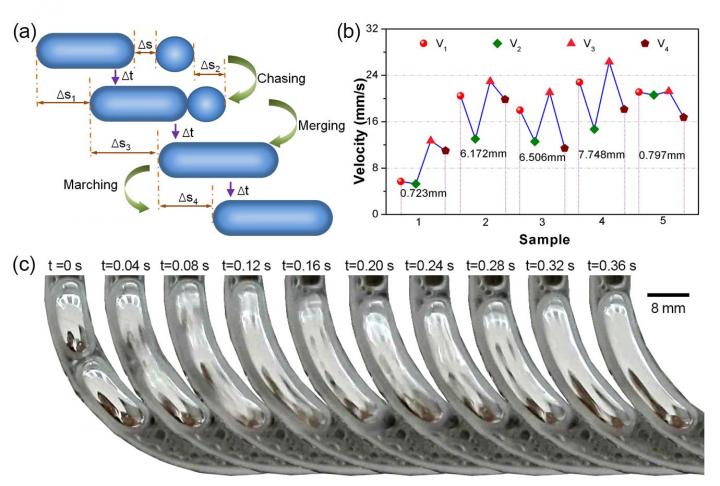Autonomous locomotion for a macroscopic liquid metal machine has been made self-actuated when fueled with aluminum (Al) flake and now a much larger liquid metal machine has been made possible.
It can autonomously move and accelerate with an increase in temperature. When dividing a large running liquid metal vehicle into several smaller ones, each of them can still maintains its traveling state along the original track. If several dispersive vehicles moved close to each other, they can coalesce seamlessly, and then still kept moving forward.
American science-fiction cinema fans are either intrigued or horrified by this notion.

The state before and after the seamless coalescence (a) Schematic for the assembly process; (b) The velocity before and after coalescence; (c) The time-evolutional coalescence process. Credit: ©Science China Press
Conventionally, it has been a challenge for a machine to achieve self-assembly without manual intervention. Self-assembly indicates a reversible process that pre-designed discrete modules could be assembled together. When assembling the machine, each module is bound to the other. And if the discrete modules are needed to work individually, each of them should be equipped with separate power sources. These processes often results in a complex design and fabrication.
Inspired by liquid metal enabled autonomous motion, which needs no external energy, a new study demonstrated that through elevating the temperature, a much larger self-propelled machine could be achieved. More importantly, during the moving process, if dividing a large machine into several smaller separately running vehicles, each of them still resumes its traveling state along the original track and chases each other.
If the volumes of such dispersive vehicles were close to each other, and they were all squeezed in the channel, the vehicles would move synchronously with oscillation.
This self-motion would become desynchronized with the interval between the different vehicles decreased gradually. If their volumes were significantly different, and the smaller vehicles were not squeezed in the channel, the faster vehicle would overtake the slower ones, until finally coalesced seamlessly. The assembled vehicle could deform itself along with change of its velocity.
This finding may shed light on future researches on smart material, fluid mechanics and soft matter to self-fueled machine. It would also offer opportunities for constructing self-reconfigurable soft robots. And you know what from Terminator 2.
Citation: ZHANG Jie, YAO Youyou, LIU Jing, Autonomous convergence and divergence of the self-powered soft liquid metal vehicles, Science Bulletin, 2015.




Comments